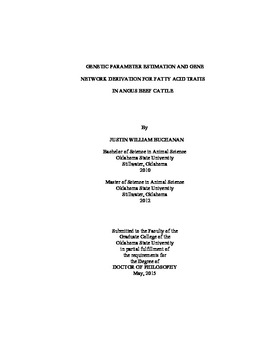| dc.contributor.advisor | Rolf, Megan M. | |
| dc.contributor.author | Buchanan, Justin William | |
| dc.date.accessioned | 2016-09-29T18:32:01Z | |
| dc.date.available | 2016-09-29T18:32:01Z | |
| dc.date.issued | 2015-05 | |
| dc.identifier.uri | https://hdl.handle.net/11244/45142 | |
| dc.description.abstract | The fatty acid profile of beef is a complex trait that affects eating quality, healthfulness attributes for the consumer, and carcass characteristics. Longissimus muscle samples were obtained from 1,833 Angus cattle to determine the intramuscular fatty acid composition for 31 lipids and lipid classes from triacylglycerol (TAG) and phospholipid (PL) fractions. Restricted maximum likelihood methods combined with pedigree data were used to estimate variance components. Heritability estimates ranged from 0 to 0.63 for the major classes of fatty acids. Heritability estimates differed between the TAG and PL fractions, with higher estimates for TAG up to 0.64 and lower estimates for PL that ranged up to 0.14. Phenotypic and genotypic correlations between pedigrees among individual fatty acids were determined for the TAG fraction as well as among carcass traits including ribeye area (REA), numerical marbling score (MARB), yield grade (YG), ether fat (EFAT), and Warner-Bratzler shear force value (WBSF). Strong negative or positive genetic correlations were observed between pedigrees among individual fatty acids in the TAG fraction, which ranged from -0.99 to 0.97 (P < 0.05). Moderate correlations between carcass traits and fatty acids from the TAG fraction ranged from -0.43 to 0.32 (P < 0.05). These results indicate that certain fatty acids prominent in beef tissues show significant genetic variation as well as genetic relationships to carcass traits. An Illumina 54k bovine SNPchip was used to determine phenotypic measures of fatty acid profile from the triacylglycerol and phospholipid fraction of longissimus muscle. Pedigree information, and genotypes were utilized to derive an annotated gene network underlying the fatty acid composition. The Bayes-B statistical model was utilized to perform a genome wide association study to estimate effects between 53,234 SNP genotypes and 39 individual fatty acid phenotypes within each fraction (TAG or PL). Effects were estimated for 1-Mbp genomic windows as well as for 54k SNP genotypes. A correlation algorithm was used to illustrate correlated regions of the genome with a set of 1 Mbp windows explaining up to 34.55% of the genetic variation in both fatty acid fractions. Annotated gene network clusters were generated by utilizing a partial correlation and information theory algorithm (PCIT) in conjunction with network scoring and visualization software to analyze correlated SNPs across 39 fatty acid phenotypes to identify SNPs of functional significance. Significantly overrepresented pathways implicated in fatty acid metabolism through network analysis included fatty acid synthesis, glycerol-phospholipid metabolism, and cell-to-cell adhesion and trafficking. A network analysis using partial correlations and annotation of significant SNPs yields functional information about the genetic mechanisms underlying the fatty acid profile of beef. | |
| dc.format | application/pdf | |
| dc.language | en_US | |
| dc.rights | Copyright is held by the author who has granted the Oklahoma State University Library the non-exclusive right to share this material in its institutional repository. Contact Digital Library Services at lib-dls@okstate.edu or 405-744-9161 for the permission policy on the use, reproduction or distribution of this material. | |
| dc.title | Genetic parameter estimation and gene network derivation for fatty acid traits in Angus beef cattle | |
| dc.contributor.committeeMember | Hoyt, Peter R. | |
| dc.contributor.committeeMember | Mateescu, Raluca G. | |
| dc.contributor.committeeMember | DeSilva, Udaya | |
| osu.filename | Buchanan_okstate_0664D_14048.pdf | |
| osu.accesstype | Open Access | |
| dc.type.genre | Dissertation | |
| dc.type.material | Text | |
| thesis.degree.discipline | Animal Science | |
| thesis.degree.grantor | Oklahoma State University | |
